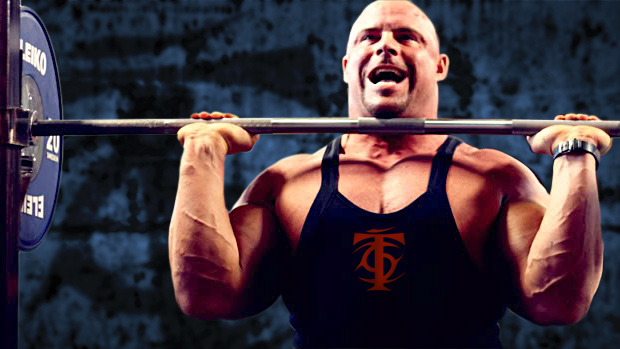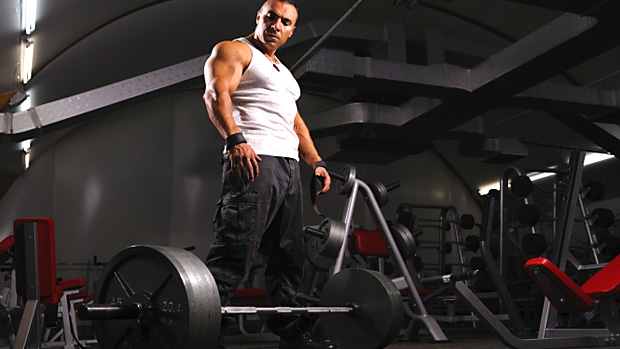Here's what you need to know...
- The rear delts play a big role in shoulder appearance, health, and strength. Hit them every workout.
- Push-ups are a prerequisite for bench pressing. Likewise, handstand push-ups are a prerequisite for overhead pressing. Do them.
- Savickas presses, where you press while sitting on the floor with your legs straight out in front of you, require incredible core strength that translates to impressive overhead pressing.
- Ignore what the exercise Nazis say. Behind the neck presses are a phenomenal muscle and strength-building move.
- Double-kettlebell rack squats build all the secondary muscles and skills involved in overhead pressing.
Add 20-30 Pounds to Your Overhead Press
Some people just aren't built for pressing. They're tall with long arms, a long torso, and long legs.
Should they just give up? Hell no. Everyone should be able to strictly press their body weight overhead... or more.
Here are five exercises and training tips that will boost your press in 6 weeks, no matter how much you lift or how long you've been stuck at your current plateau.
Incorporating even one or two of these into your current routine will boost your overhead press. The more of these you can work in, the better your results will be.
1 – Hit 'Em Every Day
The rear-delts are major players in overall shoulder health, developing that 3D shoulder appearance, overhead press strength, and general pain avoidance.
No matter what split or style of training you gravitate towards, hitting the rear-delts often is rarely a bad idea.
Rear-delts like high frequency, high volume, and lighter loads. Try doing 5 sets of 20 reps during the activation portion (where you enhance nervous system conductivity with the muscles) of every workout.
Rotate between face pulls, band pull-parts, band triple threats, 3D pull-parts, and suspension trainer T's. For variety, try "chicken wings." Yes, they look ridiculous, but you'll love the results.
Don't kill yourself with heavy weight; just get them done.
2 – Handstand Push-Ups
These aren't just for CrossFitters. How can you expect to press at least your body weight on a bar if you can't press your body?
Proper push-ups are considered by many to be a prerequisite for bench pressing, so maybe handstand push-ups (HSPUs) should be a prerequisite for overhead pressing.

Strong benching requires stability in the scapula, but most lifters ignore the lower traps and serratus, which leaves them with scapulas that wing like a bird. That's not a good place to press from, either for shoulder health or performance.
But when you stand on your hands a funny thing happens. Those scapulae are forced down by the weight of your body and those lower traps are activated, building strength in and developing muscle memory in the proper position.
HSPUs can be used as a pressing accessory or as a finisher, but since it's a high skill movement and we're using it to pattern perfect pressing posture, earlier in the workout is better. Think main move or first accessory on pressing days.
If you struggle with these, use them as a main move in the 3-6 rep range. Start with wall walks or partner supported HSPUs, and work your way up. Make sure they're in your program at least once a week.
3 – The Savickas Press
Since you can't pound your body every day with maximal loads, Savickas presses are a great way to use lighter loads but still build strength in your pressing muscles while "greasing the groove."
It also requires incredible core strength to maintain proper spinal alignment, which is a prerequisite for pressing heavy weights.

To perform the Savickas Press, sit on the floor inside a power rack with your legs straight out in front of you. The bar and J-hooks should be at shoulder height.
Unrack the bar and press from the seated position with no back support. It's just like a freestanding press, but you're sitting down. These can be used as a main move for lower reps and more sets, or done as an assistance move for higher reps and fewer sets.
As a main move, the 3-5 rep range is great. As an accessory move, shoot for sets of 6-10 to really pack some muscle on your frame.
4 – Behind The Neck Presses
These are not the taboo they were a few short years ago, but here's the disclaimer: Every coach who uses this move declares that healthy shoulders and proper mobility are prerequisites.
Christian Thibaudeau notes that it's not the behind the neck press that's the problem. It's the fact that the exercise exposes pre-existing shoulder issues.

That being said, behind the neck (BTN) pressing still isn't something you should max out on. Stick to weights in the 3-5 rep range. A favorite is a 3+3 scheme: 3 BTN strict press + 3 BTN push presses.
Each time you do them, add reps, working to 4+4 and then 5+5, before adding weight and starting the cycle over at 3+3 in your fourth workout.
Superset these with strict sub-maximum pull-ups (1-2 reps shy of failure) and your upper body will get very strong and blow up. The first time you use this combo, you'll be sore and pumped for 2-3 days afterwards!
5 – Double-Kettlebell Rack Squats
This press-builder isn't a direct shoulder move, but if you want to be a good presser, you've got to have strong legs, a crazy strong core, and you've got to have the ability to connect them under the bar.

Few things train those qualities like heavy double kettlebell rack squats. They'll also build your quads, teach you to keep your hips under you, build abs like you wouldn't believe, and boost your grip, forearms, and "rack shelf" muscles all at the same time.
Start with the heaviest KB's you can squat for 3-4 reps. Do 3 sets. Every week, add a rep. By the time you hit 3 x 10 with those same kettlebells, you won't be the same lifter.





